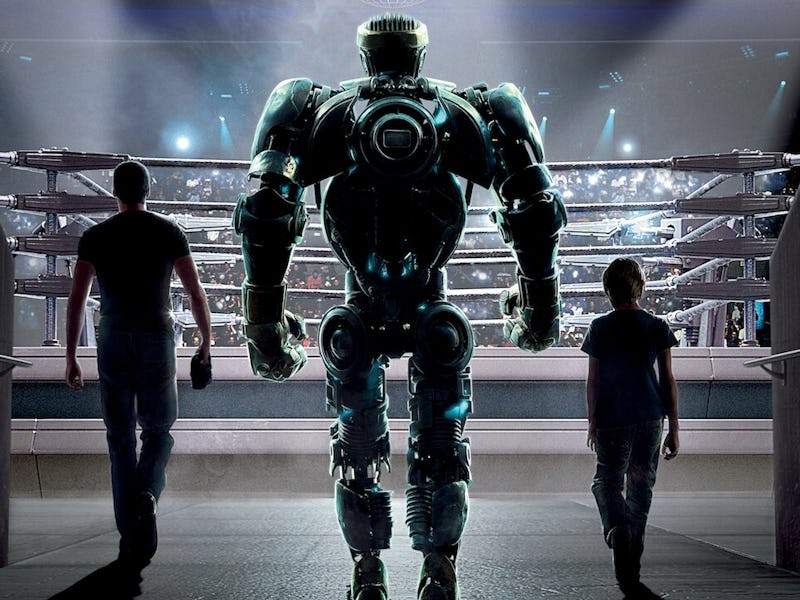You need to watch the best sci-fi sports movie on Netflix before it leaves this week
In 2011, Hugh Jackman starred in a sci-fi movie not seen before or since: a warm family sports drama with pugilist robots.

We all thought it was a Rock ‘Em Sock ‘Em Robots movie. At least, everyone I knew did. In 2012, I was a college junior enrolled in a screenwriting class. Naturally, the course was full of 19 and 20-year-old budding cinephiles discovering Godard for the first time. Just after Marvel Studios had released The Avengers, the previous summer’s sci-fi hit came into the conversation.
The Hugh Jackman movie opened at number one and grossed nearly $300 million. I’ve forgotten the specifics now, but in explaining the capitalist ecosystems that have forever driven Hollywood, my professor playfully mentioned a sequel to Real Steel was maybe being worked on at that moment. Groans filled the room.
Life is funny, though. That sequel never happened. And in this current climate, a non-franchise sci-fi film with a big-name star like Jackman at the center is a wistfully nostalgic idea, feeling antiquated in the face of franchise cinematic universes.
Time has been kind to Real Steel. In addition to standing out as maybe the best work of director Shawn Levy, Real Steel is his most focused and sincere work to date. A loose remake of a Twilight Zone episode dressed up as a sun-drenched sports film in the heart of Americana, Real Steel is a heartfelt underdog drama that still packs a rock-hard punch.
Here’s why Real Steel is the sci-fi movie you need to watch on Netflix before it leaves on October 6.
An adaptation of the short story “Steel” by Richard Matheson, also a 1963 episode of The Twilight Zone, Real Steel follows Charlie (Hugh Jackman), an inebriated former boxer and father to Max (Dakota Goyo), who he’s never met. In this alternate, then-future 2020, pro boxing involves oversized robots controlled by human boxers at ringside. (Real-life boxing legend Sugar Ray Leonard served as a technical consultant. His involvement shows. This is good choreography.)
With Max’s mother dead, custody of Max is to go to his maternal aunt and rich uncle. Sensing an opportunity to pay off debts and acquire a new robot for competition, Charlie negotiates to spend the summer with Max for a hundred grand. Little does Charlie realize is that his son is a massive robot boxing fan, which kicks off a long summer of training, bonding, winning, and losing.
Hugh Jackman stars in Real Steel, which streams on Netflix until October 6.
While still in the throes of his years as Wolverine, Hugh Jackman takes a slight left turn as Charlie, a reckless, impulsive scumbag who doesn’t think twice about the fact he sells his kid for $100K. Jackman’s onscreen charisma has deservedly made him a screen giant for over 20 years; Real Steel is simply another notch in the belt for the brawny baritone. That he works so well with Goyo is a testament to Jackman’s enduring power.
There are lots to love about Real Steel, particularly its originality and sensitivity. (And a coincidental array of Marvel actors, including Anthony Mackie, Evangeline Lilly, and even Hope Davis.) But its production design (the work of Tom Meyer) and visual effects are unavoidably attractive. It’s worth noting that not all of the robots on screen are computer-generated imagery; 26 real robots were made for the movie, all with specific functions like hydraulic neck controls.
Fellow Marvel star Evangeline Lilly co-stars in Real Steel as “Bailey,” the owner of a robot boxing gym inherited from her late father.
Though released ten years ago in 2011, Real Steel looks as if it were made yesterday. With its warm summer color tones and nostalgic Americana backdrops — an intentional choice by Levy to illustrate the father-son relationship that lies in his film’s heart — Real Steel radiates in a way that today’s too sleek and flat-colored sci-fi look now. It is sci-fi that refreshingly doesn’t take place in a dystopia. (Ironic, given its 2020 setting.) Everything on screen, from smoky state fairs to cramped boxing gyms, feels more comfortably familiar than coldly unreal.
In a 2012 interview with That Shelf, Levy discusses where he mined images to craft Real Steel. Almost none of it was other science-fiction works.
“For the aesthetics of the film we used still images more than movies,” Levy says. “My production designer, Tom Meyer, pulled such an eclectic group of stills from literally landscape books and photography books, boxing magazines, architecture books.”
The result is a movie that is, well, real. That’s what the late, great Roger Ebert said about the film. “Real Steel is a real movie,” he wrote, “It has characters, it matters who they are, it makes sense of its action, it has a compelling plot. Sometimes you go into a movie with low expectations and are pleasantly surprised."
The Falcon and the Winter Soldier’s Anthony Mackie stars in Real Steel in a minor role as an underground fight promoter.
Despite its impressive box office, a sequel to Real Steel has not happened — yet. In recent interviews for Free Guy, which Levy directed, he said he “never stopped feeling the love” for Real Steel.
“It's almost like the volume has been increasing,” Levy tells ComicBook.com. He added that he hopes to get Ryan Reynolds on board for the film with a returning Jackman. “Whether it's in Real Steel or another movie, I will direct those two amazing guys and dear friends in a movie together.”
Against all appearances, there’s heart inside Real Steel. Sure, the movie is about punching robots. There’s a Milton-Bradley toy with that same idea. But when the film is as good as one like Real Steel, earnestly so, it doesn’t matter how stupid ideas are as long as everything else feels real.
Real Steel is streaming now on Netflix until October 6.